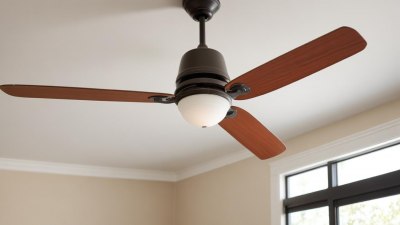The Secret Life of Ceiling Fans and Their Betrayal of Seasonal Vibes
Discover the surprising role ceiling fans play in seasonal ambiance and comfort.

This image was created with the assistance of Freepik
Ceiling fans have been a staple in homes and businesses for decades, often overlooked as mere appliances. Their simplicity belies a fascinating history and a transformative impact on seasonal living and comfort. While we often associate ceiling fans with cooling breezes in summer, they play a complex role in our experiences across different seasons. This article explores the various aspects of ceiling fans, their design evolution, and how their functionality often betrays the seasonal vibes we strive to create.
To understand the secret life of ceiling fans, we must first delve into their historical roots. The early iterations of ceiling fans date back to the 19th century, where they were originally powered by water or steam. These fans were not merely for comfort; they symbolized luxury. With the advent of electricity in the early 20th century, the design of ceiling fans began to evolve significantly. Manufacturers started producing more aesthetically pleasing models that catered to the growing demand for home decor that also served functional purposes. Throughout the 20th century, ceiling fans became common fixtures in American homes, seen as essential for keeping cool during hot summer months.
However, the history of ceiling fans is intertwined with changes in lifestyle and climate control. Fans have been lauded for their ability to circulate air, thereby reducing the perceived temperature in rooms by several degrees. This cooling effect is often celebrated in warmer months; however, as temperatures fluctuate across seasons, the reliance on ceiling fans can lead to a betrayal of the intended seasonal ambiance.
Seasonal Betrayal
As summer transitions into fall, homeowners often shift their focus to decor that evoke warmth and coziness. Pumpkin spice, warm colors, and soft fabrics fill our lives, heralding the arrival of autumn. Yet the presence of a ceiling fan can disrupt this transitional vibe. The very function of these fans is to circulate air, which is generally associated with a cooling sensation. Thus, despite our best intentions for a snug fall atmosphere, the constant whir of a ceiling fan can remind us of the heat of summer, creating a psychological dissonance in our seasonal experience.
Moreover, the functionality of ceiling fans can lead to challenges in energy efficiency. During colder months, many homeowners are unaware that ceiling fans can actually be reversed to push warm air down from the ceiling. This counterintuitive usage requires an understanding of fan mechanics that is underutilized. Failure to reverse the fan in fall and winter means wasting energy on heating or cooling costs, as warm air rises and cool air descends. Hence, the fan inadvertently betrays the season by promoting discomfort and higher energy bills.
Design and Aesthetic Considerations
When it comes to home decor, aesthetics often take precedence, especially as the seasons change. A central element of creating a seasonal atmosphere is through our environment. While ceiling fans have evolved in design, often mimicking elegant chandeliers or rustic fixtures, their stark presence can clash with seasonal decor. For example, a modern fan might seem out of place against a backdrop of fall foliage or winter wonderlands. Homeowners may find themselves frustrated, trying to balance functionality with aesthetic appeal, leading to the question: do ceiling fans enhance or detract from the aesthetic seasonality of a room?
Some interior designers advocate for integrating ceiling fans into seasonal decor through creative approaches. Swapping out blades, utilizing seasonal light bulbs, or even incorporating draping fabric can help soften a fan’s impact on the overall atmosphere. This balance between form and function could be essential in creating a cohesive seasonal ambiance while still benefiting from the ceiling fan's air circulation.
Comfort and Seasonal Adjustments
Beyond aesthetics and energy efficiency, the concept of comfort is another domain in which ceiling fans experience a betrayal. The creation of comfort is closely tied to sensory experiences. The gentle rush of air from a ceiling fan can either provide relief from the summer heat or create an unwelcome chill in winter months when we long for warmth. This discrepancy becomes apparent when adjusting the fan's speed throughout the seasons. While it may be common to run a ceiling fan on high in summer for cooling purposes, a lower speed or even turning it off entirely in winter may be necessary to foster a cozy environment. This nuanced understanding of comfort contrasts strikingly with the straightforward utility of ceiling fans.
The concept of comfort extends beyond mere temperature to include factors such as lighting, humidity, and noise level. In summer, a ceiling fan can provide a slight reduction in perceived temperature and even help cool skin by enhancing evaporation from perspiration. However, in winter, the same fan can feel intrusive, especially in a space designed for warmth and relaxation. This conflict exemplifies how ceiling fans, while beneficial, can betray the intimate comfort we seek in our seasonal experiences.
The Psychological Dimension
The role of ceiling fans also enters the realm of psychology. Our mental associations with seasons are often tied to nostalgic memories, cultural practices, and environmental cues. The psychological impact of a sinusoidal twist in the seasons—as indicated by the presence of a ceiling fan—can lead to feelings of disconnect. For instance, when we seek the cozy embrace of a warm blanket in winter, the low hum of a ceiling fan churning in the background can juxtapose the chilly atmosphere, leading to an unconscious sense of betrayal not just of seasonal decor but of emotional states tied to those seasons.
Additionally, many people often forget to adjust the settings of their ceiling fans as the seasons change, leading to increased frustration. This oversight may not only affect personal comfort levels but can also have a broader impact on mood. Understanding the necessity of changing the fan’s direction and speed can be an essential component of sustaining a harmonious seasonal vibe. By remaining aware of our surroundings and their accompanying sensations, we can minimize the psychological dissonance that ceiling fans sometimes impose upon us.
Innovative Solutions
As we continue to navigate the intricate relationship between ceiling fans and seasonal decor, innovative solutions are emerging. Smart technology has taken the ceiling fan industry by storm, with many modern fans now equipped with capabilities that allow homeowners to control settings through smartphone apps. This added convenience empowers homeowners to adjust the fan’s direction, speed, and even lighting based on weather patterns and personal preferences. Such advancements not only afford increased functionality but also reduce the burden of human oversight. These intelligent features embody a solution to the betrayal issue—no longer will the ceiling fan stand in stark contrast to heartfelt seasonal decor.
Moreover, the advent of eco-friendly ceiling fans is another exciting development. Manufacturers are becoming more attuned to consumer desires for sustainability. Energy-efficient models designed with minimal environmental impact showcase how technology can work symbiotically with seasonal desires, helping to maintain an aura of seasonal tranquility without sacrificing functionality. These eco-friendly fans often boast aesthetics that better harmonize with changing decor, creating a seamless seasonal experience.
In essence, the secret life of ceiling fans is far more intricate than their simple appearance suggests. These devices are omnipresent constituents of our living spaces, influencing not only the comfort we experience but also the aesthetic pleasure and psychological well-being tied to the seasons. While they can betray our attempts to create seasonal vibes, strategic adjustments and innovative solutions demonstrate that it’s possible to strike a harmonious balance between function and form. Understanding our ceiling fans, their usage, and how they interact with our seasonal desires will allow us to embrace their presence while fostering a comforting environment, making the most of these often-overlooked household companions.











